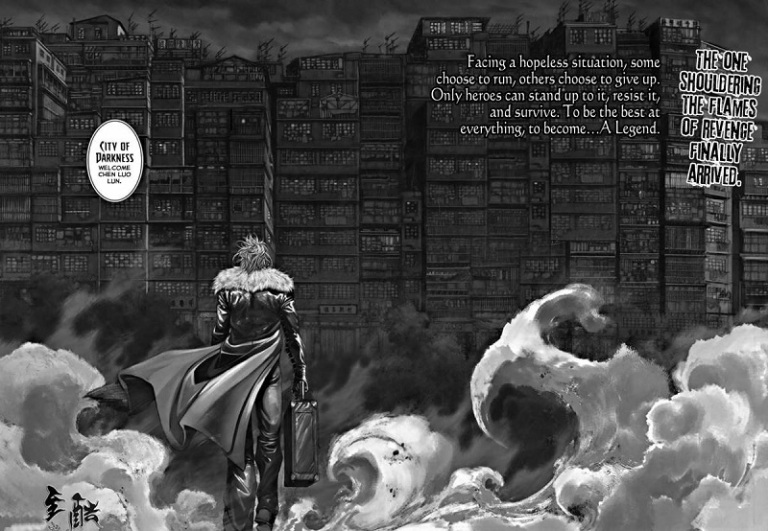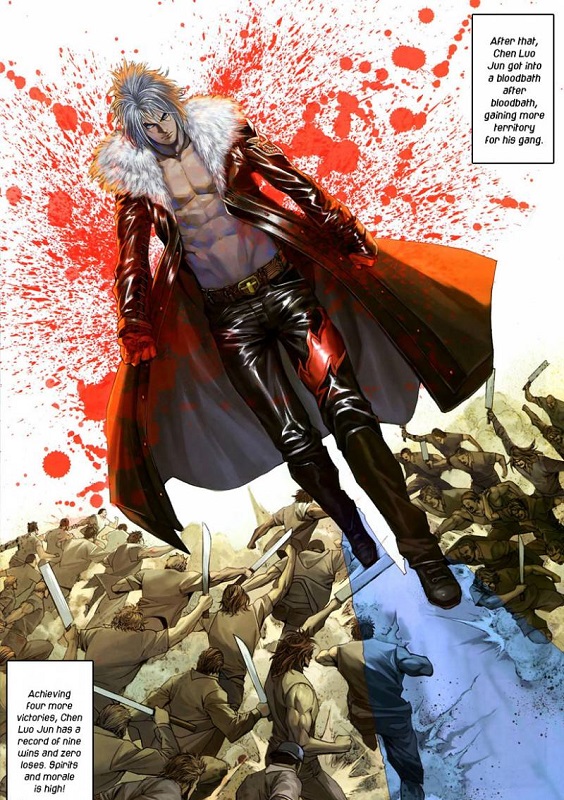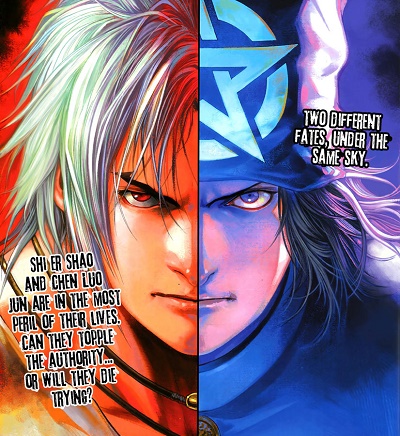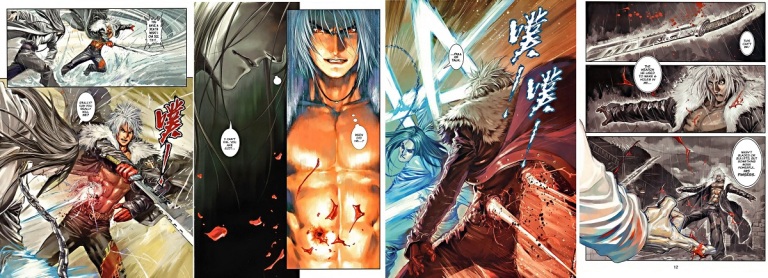The epic begins.
Chen Luo Jun is a member of the Baoli (literally "violence group") arguably the baddest gang in all of Hong Kong. Despite being with the gang for only a year he's quickly become the strongest member of the group and is known and feared throughout the criminal underworld. In his quest to conquer ten territories for his boss he's crushed numerous gangs, often times single-handedly. One evening when Luo Jun is returning to his hide-out he finds the members of his gang slaughtered by the dozens. More unsettling is the party responsible for the attack turns out to be The Boss. Luo Jun goes after The Boss to get answers but receives a sound-thrashing and a price on his head. Luo Jun flees Hong Kong for his life but vows to return one-day and claim his revenge. He seeks refuge in the City of Darkness (Kowloon), a place so dangerous even The Boss won't set foot there.
Welcome to Kowloon, the City of Darkness.
Written by Yu Er and drawn by Andy Seto, Situ Jian Qiao, Yuyongliang, and the Chenjing Group, "City of Darkness" is a manhua (Chinese comic) taking place in 1990s Hong Kong and largely centered on a fictional version of Kowloon Walled City (not to be confused with the bustling, economic powerhouse Kowloon). The comic is a wuxia title and it may be one of the best wuxia to use a contemporary setting. For readers who may be unaware, wuxia (martial hero) is a genre of Chinese fiction centered on the adventures of martial artists in ancient China. The heroes of wuxia tend to follow a particular code which corresponds to the virtue they most often symbolize. Wuxia heroes are typically chivalrous outcasts similar to Robin Hood or western gunslingers. Another aspect of wuxia fiction is the the code of xia; eight attributes (benevolence, justice, individualism, loyalty, courage, truthfulness, disregard for wealth and desire for glory) which tie into Confucianism. There is usually a character which represents each attribute but some characters can embody several which leads us to our protagonist Chen Luo Jun.
The path he walks does not change with the times.
Like other heroes in the genre, Luo Jun experiences tragedy and endures tribulations that make him a better martial artist and more importantly a better person. The streets of Hong Kong are a dangerous place and Luo Jun knows how to survive largely because of his immense skill in battle and charisma. However, he's not an Arrogant Kung Fu Guy trope nor is he a generic shonen hero. He's a simple man who just wants to build a better life for his mother and he's doing so the only way he knows how. He doesn't boast about his power or show off and he's not interested in being rich or famous, but he just wants a better life than what the streets have to offer. He carries himself with a sense of pride, but he's never conceited. He walks his own path and these and other qualities draw others to him and even his enemies admire him. However, he is loyal to a fault and this "flaw" becomes the impetus of the story's conflict because one character who doesn't share Luo Jun's code of ethics is his employer - THE BOSS.
THE BOSS
The most powerful crime lord in Hong Kong, indeed the only crime lord in Hong Kong, the Boss has made a name for himself for being cunning, ruthless, and absurdly powerful. He surrounds himself with the toughest fighters in the criminal underworld, but he's not the type to hide behind his men. Wielding fear and respect as a weapon, he'll disappear a guy to make a point and he has no problems getting his hands dirty if the situation calls for it or even if he's just bored. He conquered 18 districts in Hong Kong and if that wasn't badass enough he killed a guy with a durian (a fruit). Luo Jun summed up the Boss quite fittingly: "If the Boss wanted rain he got rain. If he wanted wind he got wind." Power, violence, and deceit are the virtues of the underworld and the Boss thrives in this environment. Faced with such a foe Luo Jun doesn't stand a chance so it's a good thing he meets unlikely allies who join him in his fight.
The Kliq
Twin Fates
Similar to Luo Jun, Shi Er Shao is a gang leader working under the Boss. When the Boss has one of his violent mood swings, he burns Er Shao's district to the ground and critically injures his friend Jixiang. According to the Boss this event was merely a test, but there's little doubt the Boss is trying to keep the troops in line after Luo Jun's defection. Shi Er Shao does not take kindly to having his friends killed and neighborhood destroyed just so the Boss can set an example and this betrayal strengthens the friendship between himself and Luo Jun.
Swim with this loan shark and get eaten.
Xin Yi is Kowloon's resident loan shark and he and Luo Jun start off as enemies. Calculating and professional, Xin Yi is a business man through-and-through and he's as violent as he needs to be, but not ruthless. He has his own code of honor and when the Boss threatens to expand his territory into Kowloon, Xin Yi rises up to protect his community.
Jason Vorhees? Not quite.
This Tornado travels by Benz.
Is that... NANTO SEIKEN?!
A fight you won't soon forget.
When I read City of Darkness I could tell it was an absolutely amazing title, but I worried if it could keep its level of polish and momentum forever. In my view it didn't. City of Darkness 2 continues the story a few years after the first part and this is where some of the issues pop up. Many of the characters are out of character in part two and while I do expect them to change and be different after the trials they went through, many of the characters go about their lives as though they didn't learn anything from part one. Characters who sought an escape from the criminal underworld in part one seem to be happy with their lifestyle in part two. This - predictably enough - draws them into some fierce, but unnecessary conflicts. While the colors remain vibrant and the fight scenes are jaw-dropping, characters are noticeably less detailed than they were in part one.
You don't cross THE BOSS.
If he dies, he dies.




































